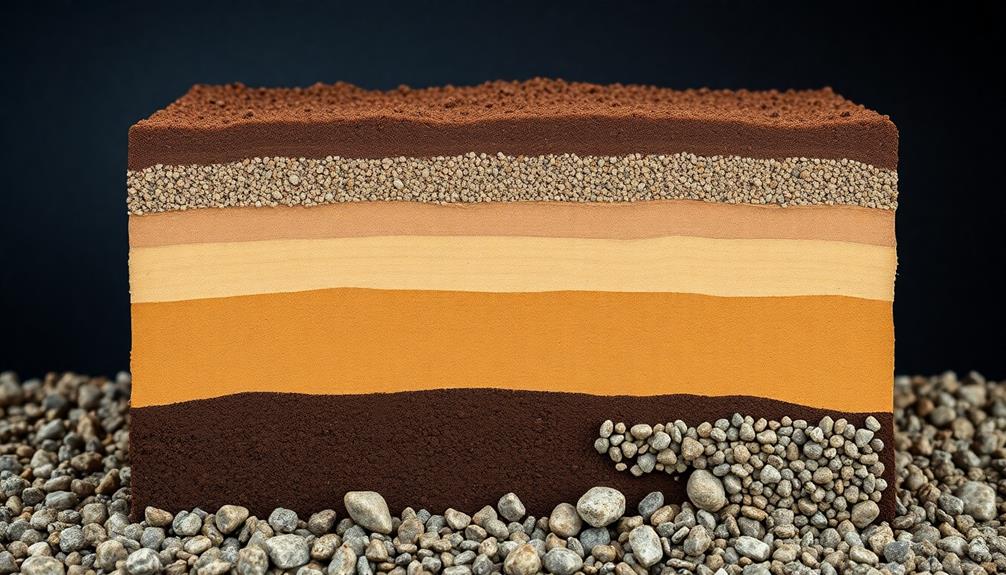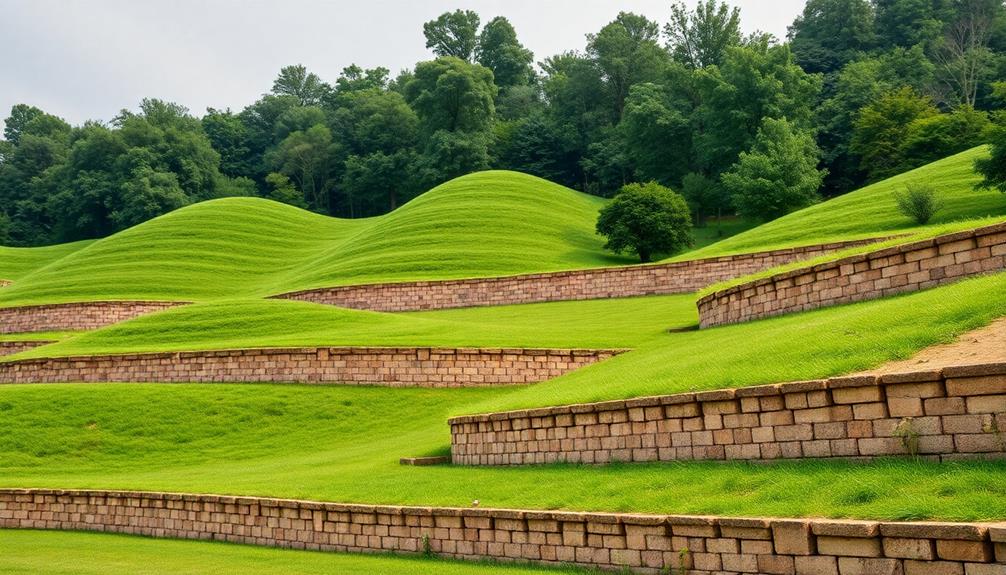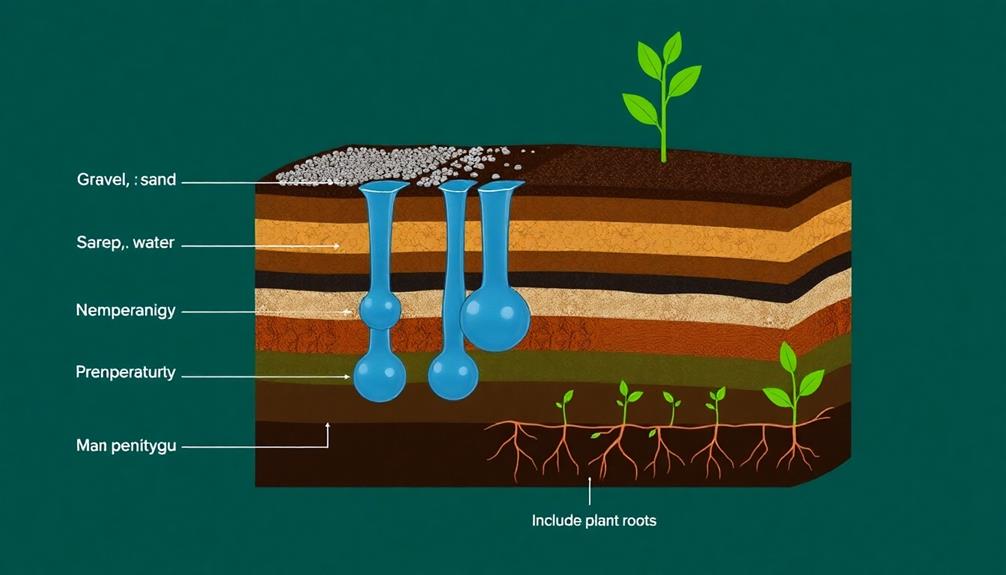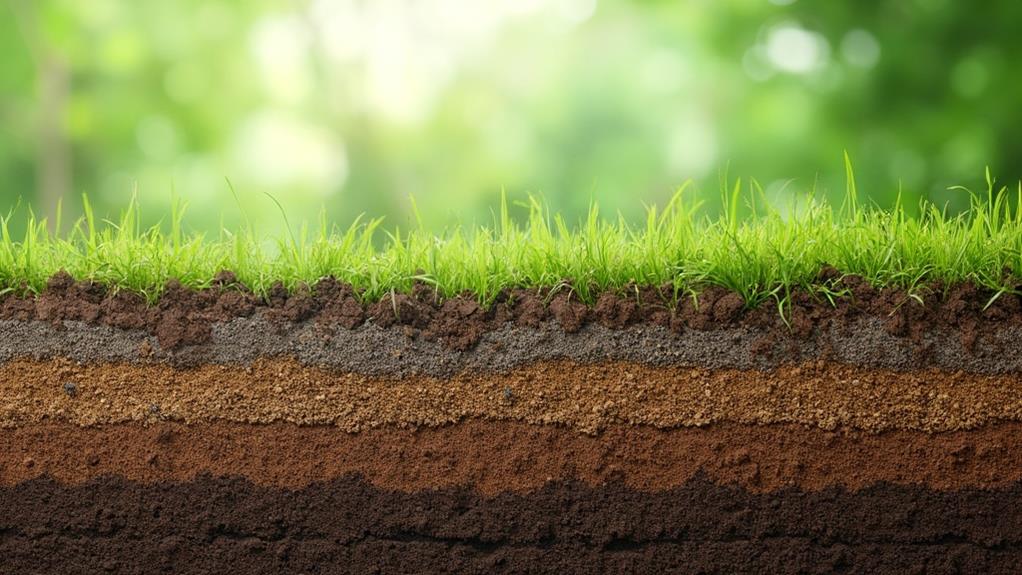Selecting the right soil type is imperative for retaining wall stability, with options such as gravel, sand, silt, clay, loam, gravelly sand, silty clay, and sandy loam, each providing unique benefits in terms of drainage, compaction, and erosion resistance. Gravel and sand excel in drainage and load-bearing capacity, essential for minimizing hydrostatic pressure, while clay and silty clay provide cohesion but require careful management of moisture levels to prevent swelling. Loam and sandy loam balance drainage with structural integrity, supporting various plantings. Understanding these soil characteristics enables the effective construction of retaining walls with enhanced durability and longevity.
Table of Contents
ToggleWalls Contractor Highlights
- Gravel soil offers excellent drainage, high load-bearing capacity, and erosion resistance, contributing to overall wall stability.
- Sand soil provides exceptional drainage, good structural support, and resists moisture-induced changes, maintaining wall stability.
- Clay soil, with high cohesion, requires meticulous compaction to manage drainage challenges and potential swelling.
- Loam soil, a balanced mix of components, supports stability, effective drainage, and diverse vegetation growth.
- Gravelly sand soil features exceptional drainage, a stable foundation for walls, and efficient water dispersal.
Soil Classification Explained

Understanding the types of soil is fundamental in constructing retaining walls, as each soil's unique characteristics meaningfully affect the stability and effectiveness of the structure. Soil classification helps identify properties such as grain size and cohesiveness, which can influence drainage and compaction.
For instance, boulder retaining walls require specific soil conditions to safeguard longevity and support. Proper soil classification facilitates the assessment of compaction requirements and informs engineers on how to ideally address drainage needs to prevent structural issues.
Understanding Soil Types
Although often overlooked in construction projects, the classification of soil is pivotal for designing effective retaining walls. Understanding soil types involves recognizing their distinct properties, which influence stability, drainage, and structural integrity. Soils are typically classified based on particle size, mineral content, and cohesiveness, falling into categories such as clay, silt, sand, gravel, and loam. Each possesses unique characteristics that can make or break the success of a retaining wall.
Clay, known for its fine particles and cohesiveness, can retain moisture but may expand or shrink noticeably with water content changes. This property makes it prone to causing structural shifts if not properly managed. Silt, with its smooth and slippery consistency, poses issues with drainage, leading to potential water buildup and pressure against the wall.
Conversely, sand and gravel, with their larger particles, offer excellent drainage capabilities, reducing hydrostatic pressure and promoting stability. Loam, a balanced mix of clay, silt, and sand, is often deemed ideal for retaining walls due to its moderate properties and good drainage while maintaining some cohesiveness. Understanding these differences is important for selecting soil that meets the project's specific needs, ensuring long-lasting and reliable retaining wall construction.
Soil Compaction Importance
Soil compaction plays an essential role in the stability and performance of retaining walls. Achieving the best possible soil compaction facilitates the correct structural support required to prevent wall movement and failure over time. Properly compacted soil enhances load-bearing capacities, fortifying the foundational integrity of retaining structures. For individuals invested in the long-term resilience of such constructions, understanding soil compaction's criticality is indispensable.
Compaction is critical because it reduces air gaps, increases soil density, and provides uniformity. Consider the following:
- Enhanced Load Support: Compacted soil can support more weight, distributing pressure evenly across the wall's foundation, thereby mitigating the risk of structural failure.
- Improved Drainage: While entirely impermeable soil may not be desirable, compacted soil can limit water flow through its strata, decreasing the potential for water-induced erosion.
- Minimized Settling: Compaction decreases the likelihood of settling that can lead to shifts or cracks in retaining walls, ensuring long-term structural alignment and aesthetic appeal.
Incorporating these aspects into design and construction leads to substantial increases in the lifespan and reliability of retaining structures. Builders and homeowners alike gain peace of mind, knowing their investments are undergirded by the fundamental principles of engineering excellence and soil science.
Drainage and Stability Factors
Providing support to retaining walls extends beyond soil compaction; drainage and stability factors also play a pivotal role in reinforcing these structures. Different soil classifications, such as gravelly, sandy, silty, and clay soils, each offer unique degrees of drainage efficiency and stability. These elements must be thoroughly understood to guarantee the integrity of the retaining wall over time.
A well-draining soil, like gravel or sand, allows water to percolate efficiently, thereby reducing hydrostatic pressure against the wall. Conversely, silty or clayey soils retain water, amplifying the pressure and potential for structural compromise.
The stability of the soil is equally indispensable. A soil's shear strength and cohesion determine its ability to withstand sliding or collapsing under weight. Cohesive soils, particularly those with moderate clay content, provide balance between drainage and stability, supporting the retaining wall effectively when properly compacted. Yet, naturally occurring clay must be monitored for its moisture sensitivity, which may pose risks if not adequately accounted for in design.
To achieve a sustainable retaining wall system, it is essential to employ an integrated approach that not only considers the soil's current classification but also proactively addresses potential changes in moisture content and its impact on stability.
Benefits

Retaining walls greatly benefit from the selection of appropriate soil types as they enhance structural integrity by providing the necessary support against lateral pressure, ensuring the wall remains stable and effective over time. The natural aspect of stone used in boulder retaining walls is alluring, and coupled with suitable soil types, they create a harmonious and visually appealing landscape.
Additionally, soils that exhibit superior drainage properties mitigate water accumulation, thereby reducing the risk of erosion that can undermine the wall's foundation. Furthermore, certain soil compositions can support diverse plantings, which not only improve aesthetic appeal but also contribute to further stabilization through root systems.
Enhances Structural Integrity
A carefully selected type of soil can greatly enhance the structural integrity of retaining walls. The choice of soil is pivotal as it influences the stability and durability of the structure, contributing to the wall's ability to withstand various physical stresses and environmental factors. By understanding the interplay between soil properties and retaining wall designs, one can confirm that the walls stand strong and serve their intended purpose effectively.
Properly compacted soil provides a solid foundation, ensuring the wall's base remains stable over time. This reduces the risk of movement or settlement that could compromise the wall's integrity.
Soils with higher cohesion, such as clay, provide binding properties that increase wall stability. Cohesive soils naturally grip the structural components, minimizing the risk of displacement or slippage.
Selecting soils with high load-bearing capacity supports the weight and pressure exerted by both the wall and surrounding earth. This is essential to preventing structural failure during adverse conditions like heavy rains or seismic activity.
These benefits emphasize the collective importance of soil selection, allowing groups engaged in construction to build retaining walls that not only serve functional needs but also foster a sense of reliability and enduring strength.
Improves Drainage Efficiency
Proper soil selection plays a critical role in enhancing drainage efficiency for retaining walls, ultimately mitigating the risk of water accumulation and related structural issues. Choosing the correct type of soil guarantees that water drainage occurs remarkably, preventing excess moisture from exerting undue pressure on retaining structures.
Soils with well-balanced compositions, such as sandy or gravelly varieties, allow for improved percolation and adequate filtration. These types of soils often possess the desired porosity, enabling water to pass through more freely and reducing the likelihood of hydrostatic pressure, which can compromise the integrity of the wall.
In achieving effective drainage, the gradation of soil particles is pivotal, as it influences the ease with which water moves through the soil matrix. Ideally, selecting soils that lack high levels of clay content is advantageous, as clay tends to retain water, impeding effective drainage.
Additionally, soils that are structured to support efficient runoff can lead to the prolonged longevity of retaining walls by preventing waterlogging. Incorporating these soil types into landscaping projects fosters a sense of security and stability for property owners, creating an environment where members of the community can confidently rely on the durability of their infrastructure.
Reduces Erosion Risks
Soil stability is paramount in reducing erosion risks associated with retaining walls, ultimately safeguarding the structural integrity of these barriers. The selection of appropriate soil is essential, as it provides necessary support and enhances wall longevity. Specific soil types mitigate against erosion by maintaining compaction and limiting the movement of earth materials. For a community keen on building sustainable environments, understanding these beneficial properties fosters a sense of belonging.
To effectively reduce erosion risks, consider the following soil characteristics:
- Compaction Resistance: Soil such as clay can be compacted to form a dense mass, reducing voids and limiting water infiltration that may lead to erosion. Its cohesive nature allows it to hold together even when subjected to pressure gradients.
- Granular Texture: Soils with a granular structure, like sandy loam, provide enhanced drainage while allowing for adequate compaction. Their coarse texture prevents water from lingering at the base of retaining walls, mitigating hydrostatic forces that can lead to erosion.
- Cohesive Properties: Silt and its slight stickiness bind particles together, creating a protective layer against surface runoff. This cohesiveness acts as a natural deterrent against soil loss, enhancing the structural resilience of retaining walls.
Supports Diverse Plantings
Selecting the right type of soil for retaining walls not only stabilizes the structure but also supports diverse plantings, enriching the surrounding ecosystem. This type of thoughtful consideration in soil selection fosters biodiversity and provides an environment where various plant species can thrive.
By opting for nutrient-rich, well-draining soil, gardeners and landscapers can create a verdant tapestry that contributes to ecological health and community sense of belonging through shared green spaces.
Integrating supportive soil encourages the growth of a wide range of plants, from vibrant flower species to robust shrubs and trees, enabling the creation of a dynamic ecosystem. Such biodiversity is crucial not only for aesthetic pleasure but also for the ecological balance, helping to attract beneficial insects and birds, which aid in pollination and natural pest control.
Additionally, diverse plantings offer a robust root network that strengthens soil stability, reducing erosion risks associated with retaining walls.
Therefore, the careful selection of soils that nurture varied plant life plays a pivotal role in maintaining structural integrity and environmental harmony. It transforms retaining walls from mere structural necessities into living, breathing extensions of the landscape, offering a shared space where nature and community coexist beneficially.
Soil Drainage Characteristics Matter

Understanding the drainage characteristics of soil is essential when constructing retaining walls, as proper drainage not only preserves soil stability but also mitigates risks associated with hydrostatic pressure. Retaining walls face significant challenges when drainage is inadequate, potentially leading to structural failure and erosion issues that could compromise the entire project. Solutions for enhancing drainage, such as installing drainage pipes or using gravel backfill, can effectively address these concerns and guarantee the longevity and integrity of retaining walls.
| Consideration | Description |
|---|---|
| Importance of Drainage | Ensures soil stability and reduces risks of pressure build-up. |
| Impact on Stability | Poor drainage can lead to soil erosion and structural failure. |
| Solutions Available | Utilize drainage pipes or gravel backfill to improve conditions. |
| Risks Without Action | Increased hydrostatic pressure may lead to wall collapse. |
| Long-term Benefits | Proper drainage extends the lifespan of retaining structures. |
Importance of Proper Drainage
Proper drainage is a critical factor in the stability and longevity of retaining walls. Without effective drainage, water accumulation can exert excessive pressure on the structure, leading to potential failure. This underscores the importance of understanding soil drainage characteristics when planning any retaining wall construction. By recognizing this inherent need, one fosters a sense of communal pride and certainty among both professionals and clients involved in such projects.
Effective drainage systems guarantee that water is efficiently redirected away from the wall, thereby preserving the structural integrity. To achieve this, several components are fundamental:
- Proper Grading: The landscape should be contoured to direct surface water flow away from the wall, reducing stress and erosion.
- Drainage Pipes: Implementing perforated pipes at the base allows underground water to be channeled away efficiently, preventing saturation that can compromise the wall.
- Gravel Backfill: The use of coarse gravel behind the wall facilitates swift water movement, reducing hydrostatic pressure.
Such measures considerably diminish risks associated with water damage, enhancing the overall safety and functionality of retaining structures. By emphasizing proper drainage, community members uphold standards of excellence, fostering robust and reliable retaining walls.
Impact on Soil Stability
Evaluating soil drainage characteristics is essential to ensuring soil stability around retaining walls. Soils that efficiently drain water contribute to a stable foundation, reducing hydrostatic pressure and promoting structural integrity. Clay-rich soils, for instance, retain water and swell, potentially compromising wall stability and causing stress on the structure. Conversely, granular soils like sand and gravel demonstrate superior drainage, directing water away and mitigating potential structural challenges. The ability of soil to moderate water flow is critical, as it directly influences erosion and subsidence risks around the wall.
Understanding these drainage characteristics fosters a sense of community among those engaged in construction and landscaping, as shared knowledge leads to stronger, more resilient projects. This collective wisdom reinforces not only the longevity of retaining walls but also the landscapes they safeguard.
Choosing the appropriate soil involves aligning drainage capabilities with the environmental demands of the site, fostering a balance that supports ecosystem health and structural firmness. When soil is selected with care, it reflects a commitment to enduring craftsmanship, where every member involved trusts that their work contributes to a stable, unified environment. This practice exemplifies the possibilities when individual expertise aligns with collective efforts, underscoring the community's shared purpose.
Solutions for Poor Drainage
To address the challenges posed by poor drainage in retaining wall projects, selecting appropriate mitigation techniques is crucial. Effective drainage solutions not only enhance the structural integrity but also foster a sense of confidence and belonging among stakeholders who benefit from safe and well-maintained infrastructures.
When dealing with soil prone to poor drainage, consideration must be given to strategic options that guarantee long-term stability and reduce hydrostatic pressure.
- Installation of Drainage Pipes: Integrating perforated pipes, or weep holes, within the retaining structure facilitates the redirection of water away from the wall and prevents water accumulation that might compromise the wall's stability. These pipes guide the water through designated paths, safeguarding the structural soundness and creating a welcoming community landscape.
- Use of Geotextiles: Employing permeable geotextile fabrics can greatly improve drainage proficiency. These fabrics act as a filter, permitting water to pass while preventing soil erosion. By maintaining soil cohesion, they contribute to a more resilient structure that harmonizes with the surrounding environment.
- Backfill Material Selection: Choosing granular backfill materials like gravel or crushed stone enhances natural drainage capabilities. This well-graded composition allows water to move freely without causing surface tension issues, promoting a balanced and cohesive structural entity that serves its intended purpose.
Walls Contractor FAQ
What Is the Lifespan of a Retaining Wall Built on Different Soil Types?
The lifespan of a retaining wall varies greatly, influenced by soil drainage, compaction, and composition. Proper assessment and engineering strategies promote longer durability, fostering a sense of reliability and community for those relying on such structures.
How Does Climate Affect the Choice of Soil for Retaining Walls?
Climate profoundly influences soil selection for retaining walls by affecting moisture levels, temperature fluctuations, and freeze-thaw cycles. Ensuring appropriate soil choice fosters community resilience and supports structural integrity, accommodating diverse geophysical and environmental conditions.
Are There Specific Soil Types to Avoid for Retaining Walls in Earthquake-Prone Areas?
In earthquake-prone areas, it is vital to avoid loose, sandy, or soft clay soils for retaining walls, as these may exacerbate seismic activity. Instead, choosing dense, well-compacted soils promotes stability and fosters a sense of safety.
What Soil Tests Are Necessary Before Building a Retaining Wall?
Before constructing a retaining wall, performing soil tests such as geotechnical investigations, compaction, and shear strength analyses is vital. This guarantees the soil's stability and strength, providing a sense of reliability and community safety in the built environment.
How Does Vegetation Impact the Stability of Soil Used for Retaining Walls?
Vegetation enhances soil stability by reinforcing soil particles with root systems, reducing erosion through canopy coverage, and promoting water absorption. Diverse planting can further stabilize soil composition, fostering a more robust and reliable structure for retaining walls.







